Cabin
Fly-fish, Swim, Hike Or Relax In This Newly Built Cabin In Northern Patagonia
Photo gallery for Fly-fish, Swim, Hike Or Relax In This Newly Built Cabin In Northern Patagonia
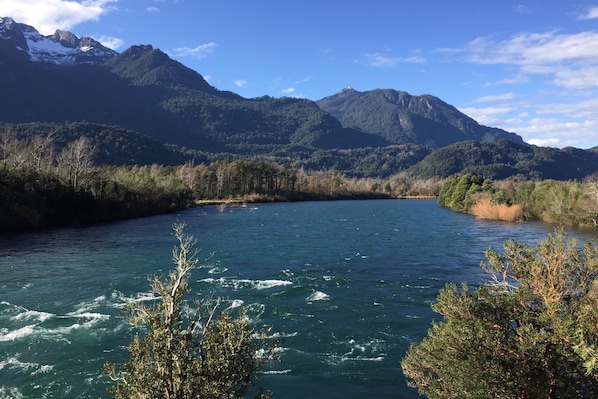
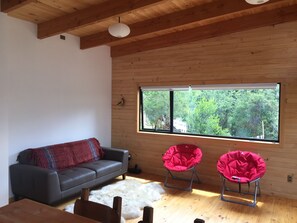
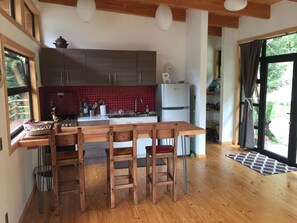
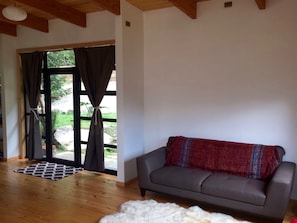
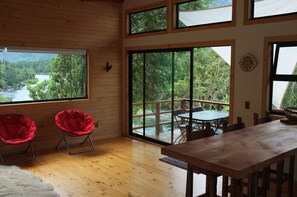
Reviews
9.6 out of 10
Exceptional
2 bedrooms1 bathroomSleeps 366 sq m
Popular amenities
Explore the area

Futrono-LLifen, Patagonia - Lago Ranco
- Nilahue Falls21 min drive
- Jumps of Riñinahue30 min drive
- Chihuío Hot Springs68 min drive
Rooms & beds
2 bedrooms (sleeps 3)
Bedroom 1
1 King Bed
Bedroom 2
2 Single Beds
1 bathroom
Bathroom 1
Toilet · Shower only
Spaces
Deck or patio
Kitchen
Garden
Dining area
About this property
Fly-fish, Swim, Hike Or Relax In This Newly Built Cabin In Northern Patagonia
A real getaway in Northern Patagonia!
We are accepting reservations for our modern-designed cabin (2016) in the Calcurrupe River, Lago Ranco region of Chile.
The property and the house: The cabin is located in a secluded and quiet enclave of the Chilean Lake District of Northern Patagonia (40° 12’ S; 72° 11’ W) nestled in the Andes mountains, about 8 kilometers from the town of Llifén, at the edge of the Calcurrupe river (the sorcerer´s road in Mapudungùn—the language of the Mapuche natives of Southern Chile). It sits in an alluvial terrace 9 meters above the water’s edge with commanding views of the river and is surrounded by mountains. The modern-style cabin has two bedrooms (one with a king bed and one with a two twin beds); a bath; a main room with an American style full kitchen; and a terrace facing the river. The river facing side of the cabin has floor-to-ceiling windows. We recently added both WIFI and a wood-burning hot tub above the bank of the Calucurrupe. The property is a 13 hectares (32 acres) plot of land on the southern slope (north-facing side) of the Calcurrupe River valley (90 m elevation). The north-facing slope of the valley is sunnier and less humid than the south-facing slope (aspect in the southern hemisphere is the reverse of the northern hemisphere). The property has about 350 meters of private riverfront with a private beach and, a natural river pool of about 10 meters deep where the Chinook and Coho salmon spawn at the end of the summer (March-April). To the back, the property extends to the slopes of the Auquinco hills (1000 meters), where there are hiking trails to a high viewpoint (overlooking the lakes and the Andes) and to a glacial lake. The hills are covered with native forest, and there are some great areas for rock climbing right in the back of the house (the rock is igneous diorite).
The cabin is surrounded by the Valdivian temperate rainforest with a mix of deciduous and evergreen trees that are native only to this region of the world. For example, Maqui (Aristotelia chilensis) or Chilean wineberry, is a small evergreen deciduous tree reaching 4–5 m in height of the Elaeocarpaceae family that grows wild and is native to the Valdivian temperate rainforests of Chile and adjacent regions of southern Argentina. Maqui grows abundant and wild all over the hillsides surrounding the cabin. The Maqui fruit is an intensely purple berry that the Mapuche native people have collected for centuries to eat and drink its juice. They collect the edible Maqui berries from December to March each year. The process involves collecting the side branches of trees, shaking them to separate the berries, and then separating the berries from leaves. The purple pigments of Maqui berries are very rich in anthocyanins: a powerful anti-inflammatory antioxidant compound that helps to reduce the risk of a variety of degenerative diseases that involve inflammation. So if you are in the site in the summer months of the Southern hemisphere (Jan-Mar.), you can collect Maqui berries for a delicious pie or/and berry juice.
Fly-fishing in the Calcurrupe: Step out of the house and walk a few steps down to the river and you’ll be fishing in one of best spots for fly-fishing in Northern Patagonia. Roderick Haig-Brown, in his book Fisherman’s Winter, stated that the town of Llifén (and the Calcurrupe river) is the best fishing center in Chile. The town of Llifén has a deep and long fly-fishing tradition that dates back to the early 1900s, when many skilled European fishermen came attracted by the excellent fishing and the strength of the trout in Lake Ranco and in the Calcurrupe River. The first small factories of flies in South America and one of the first fly-fishing lodges in the Chilean Patagonia were established in the town of Llifén. Today the Calcurrupe and the town of Llifén have a well-established reputation as a trout fisherman's choice destination. The fishing season opens the second Friday of November and closes the first Sunday of May. The months of November to February are best for trout (rainbow and brown) fishing, and March and April are ideal for Chinook and Coho Salmon. The caretaker lives near the cabin in the Auquinco community, and is an expert fishing guide with a McKenzie ‘style’ boat for drift boat fishing. The river flows westward from the Andes, draining the glacial mountain lake Maihue (Mapudungun for Wooden glass) into the larger Ranco Lake (Mapudungun for surf-water) located in the Andes foothills. The Calcurrupe is 15 kilometers long and about 50-80 meters wide, with a discharge of 175 m3/s of aqua/teal color of rushing waters. For trout fishing, local fishermen usually use a 5-6 wt rod with a weight forward sinking tip flyline of 120-200 (100 yd. 20 Lb. backing) with a another reel with a floating line. For salmon, they usually use a 7-8 wt rod with a sinking tip flyline of 250-350.
The surrounding region: There are plenty of sightseeing and outdoor opportunities in the area: hiking, exploring, bird watching, kayaking on the Ranco Lake, or boat drifting on the river. The Carrán-Los Venados and the Puyehue-Cordón Caulle volcanic complexes (1000 m) are located 30 miles to the South. On the North side of the Calcurrupe valley, there are snow capped (during the winter) hills of 1500 m covered with native forest. A road on that side will take you to the Maihue Lake and the surrounding mountains. The shores of the Ranco Lake (the third largest in Chile with 410 km2 or 158 sq. mi) are home to more than 300 natives communities. A scenic highway has been recently completed that circles the Ranco Lake. There are local artisans selling their crafts in the communities and towns around the Lake (woolens, rauli wooden crafts). Also, there is a rich equestrian tradition with horse farms and rodeos, where the local Huasos (Chilean cowboys) display their skills and traditions. A visit to the Huapi Island, in the Ranco Lake, provides a unique opportunity to experience the island’s rich native cultural heritage and stunning natural beauty. A ferry makes the crossing from the town of Futrono (the town of smoke clouds). Local artisans manufacture woolen textiles, woodcarvings and basketry that are displayed in the markets during the summer. The near town of Llifén (5 miles/8 kms) has all the basic amenities needed: a small market, a restaurant (Apumanque), small medical facilities, grocery store, and a hot spring. The larger town of Futrono is only 17 miles (28 kms) and has a greater offering of amenities and shopping. Great dining is found at the restaurant overlooking the Ranco Lake, the Pellin y Coigue. Farther afield, there are National Parks, volcanoes, glacial lakes, hot springs, and the majestic Valdivian rainforest. The cities of Valdivia, Puerto Varas, and Puerto Montt also offer other sightseeing opportunities. The Region is served by the Valdivia airport, 70 miles/100 kilometers to the East, and the Puerto Montt airport, 200 kilometers to the South, both with daily flights between Santiago and the region. Both airports have major car rental companies’ facilities.
We are accepting reservations for our modern-designed cabin (2016) in the Calcurrupe River, Lago Ranco region of Chile.
The property and the house: The cabin is located in a secluded and quiet enclave of the Chilean Lake District of Northern Patagonia (40° 12’ S; 72° 11’ W) nestled in the Andes mountains, about 8 kilometers from the town of Llifén, at the edge of the Calcurrupe river (the sorcerer´s road in Mapudungùn—the language of the Mapuche natives of Southern Chile). It sits in an alluvial terrace 9 meters above the water’s edge with commanding views of the river and is surrounded by mountains. The modern-style cabin has two bedrooms (one with a king bed and one with a two twin beds); a bath; a main room with an American style full kitchen; and a terrace facing the river. The river facing side of the cabin has floor-to-ceiling windows. We recently added both WIFI and a wood-burning hot tub above the bank of the Calucurrupe. The property is a 13 hectares (32 acres) plot of land on the southern slope (north-facing side) of the Calcurrupe River valley (90 m elevation). The north-facing slope of the valley is sunnier and less humid than the south-facing slope (aspect in the southern hemisphere is the reverse of the northern hemisphere). The property has about 350 meters of private riverfront with a private beach and, a natural river pool of about 10 meters deep where the Chinook and Coho salmon spawn at the end of the summer (March-April). To the back, the property extends to the slopes of the Auquinco hills (1000 meters), where there are hiking trails to a high viewpoint (overlooking the lakes and the Andes) and to a glacial lake. The hills are covered with native forest, and there are some great areas for rock climbing right in the back of the house (the rock is igneous diorite).
The cabin is surrounded by the Valdivian temperate rainforest with a mix of deciduous and evergreen trees that are native only to this region of the world. For example, Maqui (Aristotelia chilensis) or Chilean wineberry, is a small evergreen deciduous tree reaching 4–5 m in height of the Elaeocarpaceae family that grows wild and is native to the Valdivian temperate rainforests of Chile and adjacent regions of southern Argentina. Maqui grows abundant and wild all over the hillsides surrounding the cabin. The Maqui fruit is an intensely purple berry that the Mapuche native people have collected for centuries to eat and drink its juice. They collect the edible Maqui berries from December to March each year. The process involves collecting the side branches of trees, shaking them to separate the berries, and then separating the berries from leaves. The purple pigments of Maqui berries are very rich in anthocyanins: a powerful anti-inflammatory antioxidant compound that helps to reduce the risk of a variety of degenerative diseases that involve inflammation. So if you are in the site in the summer months of the Southern hemisphere (Jan-Mar.), you can collect Maqui berries for a delicious pie or/and berry juice.
Fly-fishing in the Calcurrupe: Step out of the house and walk a few steps down to the river and you’ll be fishing in one of best spots for fly-fishing in Northern Patagonia. Roderick Haig-Brown, in his book Fisherman’s Winter, stated that the town of Llifén (and the Calcurrupe river) is the best fishing center in Chile. The town of Llifén has a deep and long fly-fishing tradition that dates back to the early 1900s, when many skilled European fishermen came attracted by the excellent fishing and the strength of the trout in Lake Ranco and in the Calcurrupe River. The first small factories of flies in South America and one of the first fly-fishing lodges in the Chilean Patagonia were established in the town of Llifén. Today the Calcurrupe and the town of Llifén have a well-established reputation as a trout fisherman's choice destination. The fishing season opens the second Friday of November and closes the first Sunday of May. The months of November to February are best for trout (rainbow and brown) fishing, and March and April are ideal for Chinook and Coho Salmon. The caretaker lives near the cabin in the Auquinco community, and is an expert fishing guide with a McKenzie ‘style’ boat for drift boat fishing. The river flows westward from the Andes, draining the glacial mountain lake Maihue (Mapudungun for Wooden glass) into the larger Ranco Lake (Mapudungun for surf-water) located in the Andes foothills. The Calcurrupe is 15 kilometers long and about 50-80 meters wide, with a discharge of 175 m3/s of aqua/teal color of rushing waters. For trout fishing, local fishermen usually use a 5-6 wt rod with a weight forward sinking tip flyline of 120-200 (100 yd. 20 Lb. backing) with a another reel with a floating line. For salmon, they usually use a 7-8 wt rod with a sinking tip flyline of 250-350.
The surrounding region: There are plenty of sightseeing and outdoor opportunities in the area: hiking, exploring, bird watching, kayaking on the Ranco Lake, or boat drifting on the river. The Carrán-Los Venados and the Puyehue-Cordón Caulle volcanic complexes (1000 m) are located 30 miles to the South. On the North side of the Calcurrupe valley, there are snow capped (during the winter) hills of 1500 m covered with native forest. A road on that side will take you to the Maihue Lake and the surrounding mountains. The shores of the Ranco Lake (the third largest in Chile with 410 km2 or 158 sq. mi) are home to more than 300 natives communities. A scenic highway has been recently completed that circles the Ranco Lake. There are local artisans selling their crafts in the communities and towns around the Lake (woolens, rauli wooden crafts). Also, there is a rich equestrian tradition with horse farms and rodeos, where the local Huasos (Chilean cowboys) display their skills and traditions. A visit to the Huapi Island, in the Ranco Lake, provides a unique opportunity to experience the island’s rich native cultural heritage and stunning natural beauty. A ferry makes the crossing from the town of Futrono (the town of smoke clouds). Local artisans manufacture woolen textiles, woodcarvings and basketry that are displayed in the markets during the summer. The near town of Llifén (5 miles/8 kms) has all the basic amenities needed: a small market, a restaurant (Apumanque), small medical facilities, grocery store, and a hot spring. The larger town of Futrono is only 17 miles (28 kms) and has a greater offering of amenities and shopping. Great dining is found at the restaurant overlooking the Ranco Lake, the Pellin y Coigue. Farther afield, there are National Parks, volcanoes, glacial lakes, hot springs, and the majestic Valdivian rainforest. The cities of Valdivia, Puerto Varas, and Puerto Montt also offer other sightseeing opportunities. The Region is served by the Valdivia airport, 70 miles/100 kilometers to the East, and the Puerto Montt airport, 200 kilometers to the South, both with daily flights between Santiago and the region. Both airports have major car rental companies’ facilities.
Property manager
Leslie Prock and Antonio Bellisario
Languages
English, Italian, Spanish
Add dates for prices
Amenities
Hot tub
Kitchen
Washer
Free WiFi
Outdoor space
Mountain view
Have a question?
BetaGet instant answers with AI powered search of property information and reviews.
Similar properties
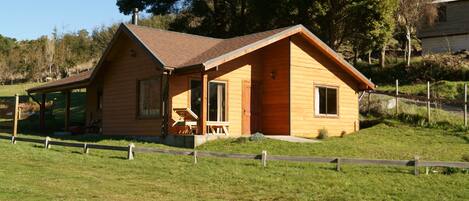
beach shore hut
beach shore hut
- Living/dining area
House Rules
Check in after 10:00 AM
Minimum age to rent: 25
Flexible check-out available (contact host to arrange)
Children
Children allowed: ages 0–17
Events
No events allowed
Pets
No pets allowed
Smoking
Smoking is not permitted
Important information
Fees
You'll be asked to pay the following charges at the property. Fees may include applicable taxes:
- You may be asked to pay the following charges at the property: Chile value-added tax (19%). Nonresident travellers who pay using a foreign card or bank transfer and who present a valid passport and tourist visa may be exempt from value-added tax (19%).
We have included all charges provided to us by the property.
You need to know
Extra-person charges may apply and vary depending on property policy
Government-issued photo identification and a credit card, debit card or cash deposit may be required at check-in for incidental charges
Special requests are subject to availability upon check-in and may incur additional charges; special requests cannot be guaranteed
On-site parties or group events are strictly prohibited
Host has indicated that there is a carbon monoxide detector on the property
Host has indicated that there is a smoke detector on the property
Safety features at this property include a fire extinguisher, a first aid kit and a deadlock
About the area
Lago Ranco
Located in Lago Ranco, this cabin is in the mountains and on a river. The area's natural beauty can be seen at Ranco Lake and Nilahue Falls. Discover the area's water adventures with fishing and swimming nearby, or enjoy the great outdoors with hiking/biking trails.

Futrono-LLifen, Patagonia - Lago Ranco
What's nearby
- Saltos Del Nilahue Viewpoint - 21 min drive - 15.6 km
- Nilahue Falls - 21 min drive - 16.0 km
- Jumps of Riñinahue - 30 min drive - 24.5 km
- Pico Toribio - 43 min drive - 33.0 km
- Chihuío Hot Springs - 68 min drive - 49.8 km
Restaurants
- Restaurant La Buena Mesa - 17 min drive
- Bodega Chumpeco - 19 min drive
- Comidas al paso Anita - 16 min drive
Frequently asked questions
Reviews
Reviews
No reviews yet
Be the first to leave a review for this property after your stay.
About the host
Hosted by Leslie Prock and Antonio Bellisario
Leslie Prock and Antonio Bellisario
Languages:
English, Italian, Spanish
Tell us how we can improve our siteShare feedback